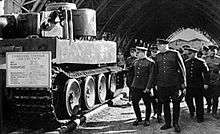Captured German equipment in Soviet use on the Eastern front

During World War II losses of major items of equipment were substantial in many battles. Due to the expense of producing such equipment, many armies made an effort to recover and re-use enemy equipment that fell into their hands.[1]
Equipment Capture
Small items of equipment such as personal firearms, clothing and so forth are routinely lost as personnel are wounded, killed, or taken prisoner. There is often a perception (and sometimes a reality) amongst soldiers that the foreign equipment is better or more convenient than the equipment issued by the soldier's own Army. Thus it was not uncommon for Soviet troops to make use of German boots, knives, mess kits, flashlights and other personal items. Likewise, German troops often sought Soviet winter boots (vаlenki) and hats. Oddly, troops on both sides each favored the other's submachineguns. Photos of German troops using Soviet PPSh-41 submachineguns are as common as photos of Red Army troops using German MP-40s.
For larger items such as tanks or artillery pieces, equipment can be lost when it is immobilized through breakdown or minor damage. In general, a retreating force tends to lose a lot of heavy equipment regardless of actual combat losses. The heavy maintenance demands of armored fighting vehicles are both a cause of loss and an obstacle to re-use. For example, after the Battle of Stalingrad, several hundred German Panzer III tanks were captured. So many were available that an effort was made to repair and re-use them. Hundreds were rebuilt as the SU-76i self-propelled gun.
Artillery pieces can also be lost during retreats, when battery positions are overrun, or when they are immobilized during road movement.
Use of Captured Equipment
Captured equipment was of more value to the Soviets as a source of intelligence on German equipment capabilities and weaknesses than they were for use on the battlefield. The first examples of German Tiger I tank and Königstiger tanks captured in combat were sent to Soviet proving grounds for evaluation. Photographic evidence does exist of usage of German equipment by the Soviets, but their use was usually for short periods of time.
Use of captured equipment has obvious benefits and less-obvious drawbacks. When Axis tanks were captured and could be repaired for use, they were often used in deception operations. A common tactic was for a Soviet tank unit to approach a German position using one or two captured German tanks in the lead. The hope was that the German defenders, recognizing a "friendly" tank, would not fire, or would delay their fire long enough for the Soviet unit to make a close approach.
Axis tanks and other AFVs were also re-marked and sometimes re-armed with Soviet weapons. One such example is the SU-76i assault gun based on captured Panzer III. Evidence also exists of German Panzer I-based command vehicles re-armed with Soviet 20mm ShVAK cannons. Usually, however, the vehicles were neither modified nor re-marked.
The drawbacks to using enemy equipment are significant. First, the captured vehicles are very often mistaken as enemy and thus are subject to friendly fire. Second, it is difficult to repair or maintain them; the simple act of obtaining ammunition or minor engine parts can be insurmountable. Third, equipment such as radios may not be compatible with other friendly equipment. Fourth, troops may not understand the maintenance requirements of the unfamiliar enemy equipment.
With the exception of the Panzer III tank, most of the vehicles listed below were captured in very small numbers and never contributed significantly to Red Army strength in any operation.
Example Listing of Captured equipment
Captured German Armored Fighting Vehicles
- Panzer 38(t) medium tank
- SdKfz 11 artillery tractor
- SdKfz 250 armored halftrack
- Panzer IV tank
- Sturmgeschutz III assault gun
- Panzer III tank.
- Tiger I tank
- Tiger II tank
- Panther tank
- SdKfz 301 Borgward
- Panhard 178 ex-French armored car employed by the Germans
- Panzer II light tank
Example Listing of Other Axis Vehicles
Captured Aircraft
- Bücker Bü 133 Jungmeister
- Dornier Do 215
- Fieseler Fi 156 Storch
- Gotha Go 145
- Focke-Wulf Fw 190
- Focke Wulf Fw 190 D-9
- Focke-Wulf Fw 189
- Heinkel He 111
- Messerschmitt Bf 109
- Henschel Hs 126